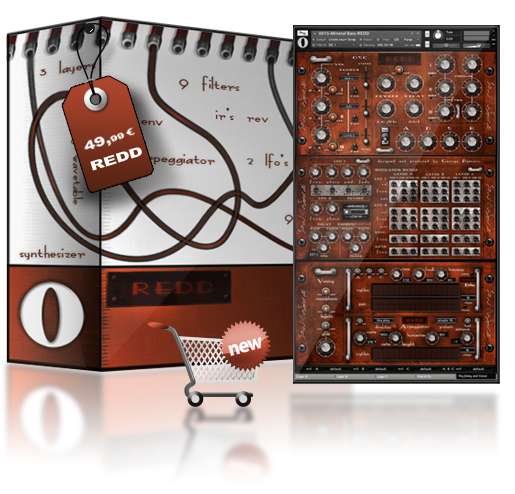| Software Music Machine Archive |
|
|
by SoulViaSound
(SoulViaSound Website) |
Operating System:
File Size:
License:
Price: EUR 49 License Conditions: Demo version don't keep persistance, 20 blocked patches instead 92 unblocked in commercial version. System Requirements: Kontakt 4.2 Last Updated: 2011-03-08
For more detail about software : Software Description
|
View REDD - Hybrid Synthesizer Screenshot |
Software Description
REDD is a hybrid synthesizer created for Kontakt owners, and produced by George Poenaru. REDD can't be loaded in older version than Kontakt 4.2. Before starting presentation you must know that main knobs were designed without cursor for one reason: tweaking sound wouldn't involve the eyes, so you'll use only your ears. In this moment REDD have 2 different nki's type: "REDD" and "REDD Lite". "REDD" use 9 wavetable sources distributed in 3 layers and REDD Lite use only 3 wavetable sources distributed on a single layer. The reason of "REDD Lite" appearance is about saving CPU. "REDD" use 35 waves and noises type (Kontakt groups) for each of the 9 sources (314 groups) and "REDD Lite" use 35 waves and noises types (Kontakt groups) for each of the 3 sources (105 groups). A new "REDD Selection" will be available soon and will use only 5 waves and noises type (Kontakt groups) for each of the 9 sources (45 groups). Controls Panels:
* Layer panel
* Modulation and FX panel
* Arpeggiator, MIDI Delay and Voicing panel
Layer panel
Analog synthesizer use VCO to generate different waves and noise type (sine, triangle, rectangular, saw tooth, pink noise, etc.), REDD doesn't generate anything, it use a large wavetable recorded from popular analog VCO, noise generators, and virtual analog DCO. In addition, REDD wavetable contain analog tape hiss and analog HUMM. You can find 35 different source in each of the 9 source section in "REDD", or in each of the 3 source in "REDD Lite". Recording was made note by note and the loop points have been carefully chosen, considering also the VCO pulse width modulation. The REDD wavetable contain:
* 1xSine Wave Type
* 1xTriangle Wave Type
* 4xSaw tooth Wave Type
* 7xRectangular Wave Type
* 2xPulse Wave Type
* 5xCombination Wave Type
* 1xLowF. Sine Wave Type
* 4xNoise Type
* 4xPink Noise Type
* 4xWhite Noise Type
* 1xAnalog humm
* 1xAnalog Tape hiss
On the layer panel you'll find 3 oscillators sources menu, on/off switch, oscillator range switch, volume, pan, spread, filters for each of the 3 oscillator sources, amp and filters ADSR envelope for the entire layer, reverb send, delay send, chorus send, layer volume and a layer on/off switch.
Modulation and FX panel
On this panel you can control the 2 LFO's, time delay, chorus/phaser, modulation intessity and also selecting the reverb preset. The REDD reverb it's based on IR's and you browse through 7 types of reverb:
* Ambiances
* Chambers
* Hall
* Non Linear
* Plate
* Room
* Spaces
On modulation matrix you can modify the modulations intensity for each of the 9 sources. What makes it special compared with other synthesizers, besides the consistent wavetable, is the isolating each of the 9 sources:
* isolated modulation intensity and filters for each of the 9 sources
* isolated volume and filter envelope for each of the 3 layers
* isolated output for each of the 3 layers
Arpeggiator, MIDI Delay and Voicing panel
In this panel you can control the arpeggiator, MIDI delay and instrument voicing (legato, portamento and mono). Also, here you can route REDD layers to different Kontakt outputs.